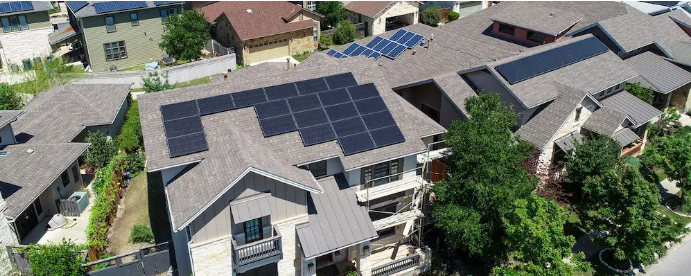Austin Energy is one of the leading municipal utilities in the United States when it comes to solar energy. The company currently provides the most per capita of any municipal utility with over 3,000 watts of solar energy per person with a goal of achieving 100% renewables by 2035.
The utility has invested heavily in solar and is one of the only utilities to place value not only on the impact solar panels have on the grid but also on the effects they have on the environment. Despite it seeming like it’s a no-brainer to go solar in Austin, there are a few things homeowners should know before they decide to make the switch.
That’s why we’ve put together an outline of everything you need to know about going solar with Austin Energy. We’ll cover how much going solar will cost you to how much money the utility’s unique Value of Solar program can actually save you.
How much do solar panels cost in Austin?
Austinites would need to spend about $22,400 to cover most of the costs of a $150 electricity bill. When you take the 30% federal solar tax credit and the Austin Energy residential solar rebate into account, that price drops to about $13,920.
How to qualify for the Austin Energy solar rebate
Austin Energy offers a $2,500 rebate to help homeowners reduce the upfront cost of installing solar panels. In order to get the rebate, the solar system must be at least 3 kilowatts (kW) in size, must be installed by an Austin Energy Participating Contractor, and buyers must complete the Austin Energy Solar Education Course before applying.
Once you choose a solar company to complete the installation and finish the Solar Education Course, you’ll sign a Customer Agreement Form. From there, Austin Energy will issue a confirmation letter that you are eligible for the rebate. You will receive a rebate check from the City of Austin in the mail after the solar installation is complete.
How much can solar panels save you on your Austin Energy bill?
Solar panels can eliminate most of your energy bill and in some cases all of it, depending on your energy consumption and the size of your solar system. An 8.14 kW solar panel system can provide Austin Energy homeowners with almost $1,500 in savings per year!
Austin Energy has developed a unique approach when it comes to paying its customers for the solar energy they produce. Instead of traditional net metering, the utility offers a Value of Solar Rate that takes the monetary value of customers generating solar energy and its environmental benefits into account.
How does the Austin Energy Value of Solar rate work?
Austin Energy’s Value of Solar rate is pretty straightforward. Your electricity bill will list the number of kilowatt-hours your home used and the number of kilowatt-hours your solar panels produced. You are billed for 100% of the electricity your home uses at the utility’s residential electric rate. This is sometimes referred to as a “buy-all, sell-all” program.
All of the solar energy your panels produce is credited at the Value of Solar rate, which is equal to $0.097 per kWh. If your total solar credit is worth more than your electric bill costs, the excess credit will roll over and be applied to your next bill.
Let’s take a look at an example to get a better idea of how you’ll be billed with the Value of Solar rate.
Say your home used a total of 1,200 kWh of electricity in one month, your energy costs including additional charges would come out to about $114. In that same month, your solar panels produced 1,000 kWh of solar electricity, for a total Value of Solar credit of $97. This brings your total bill down from $114 to just $17.
Will you still get an Austin Energy electricity bill with solar panels?
Yes, you will most likely still get an electricity bill from Austin Energy every month. There are a few reasons for this, one being that the Value of Solar rate is technically lower than what you pay for electricity from the grid once you consider all charges and fees. So, the utility pays you less for the energy your panels produce than what it charges you for the electricity your home used.
Not only that, but the buy-all, sell-all structure of the program makes it so your solar energy doesn’t fully offset the costs of using energy. Usually, a utility will bill you based on the amount of energy you used from the grid, meaning if you used the energy your panels generated, you wouldn’t be billed for it because you didn’t take the energy from the grid.
Austin Energy, on the other hand, just bills you for all of your energy consumption, regardless if it came from your panels or the grid. Overall, this leads to lower savings and makes it difficult to offset all of your energy costs. Plus, the Value of Solar credits cannot be used to eliminate any charges or fees from the City of Austin, like taxes.
So, solar panels probably won’t get rid of your entire electricity bill, but they can greatly reduce it because the Value of Solar rate isn’t drastically lower than the retail rate. You can still see over $1,000 in electricity bill savings over the course of the year!
Should Austin Energy customers install a solar battery?
Thanks to frequent power outages occurring throughout the state, Texans are more concerned than ever about having access to backup power. If keeping your lights on and your fridge running during a power outage is a top priority for you, then a solar battery is definitely worth considering.
Solar batteries like the Tesla Powerwall and the Enphase IQ allow you to store excess solar energy produced by your solar panels so that it can be used by your home if the power goes out. Without a battery, solar panels will not continue to power your home.
Unfortunately, batteries don’t come cheap – an average-sized lithium-ion battery will run you a minimum of $10,000. And because of how Austin Energy bills solar customers, using a battery to power your home at night won’t save you any additional money. So, it’s up to you to decide if the peace of mind that you’ll have when the grid goes down is worth a couple of thousand dollars.


